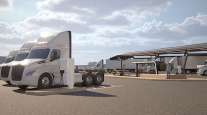Senior Reporter
FHWA Releases Grants for Electric Truck Chargers

[Stay on top of transportation news: Get TTNews in your inbox.]
While federal officials were touting the latest round of electric charging infrastructure grants for cars in rural and other communities nationwide, there also was modest good news for trucking.
WattEV received the biggest single allotment to build out heavy-truck chargers on California’s Interstate 5.
“It was very rewarding to see that we got almost 10% of the total pool and over 50% of the money for California,” CEO Salim Youssefzadeh said in mid-January.
The Federal Highway Administration funding award of $76 million came on the heels of the company receiving $33 million late last year from the Transportation Corridor Enhancement Program, bringing WattEV’s recent total to $109 million, according to the company.

Youssefzadeh
In total, about one-third of the grants awarded, totaling $622 million, were for truck charging infrastructure.
Youssefzadeh said the most recent $76 million injection of federal money to WattEV is “creating a path to electrify from the border of San Diego all the way up to the state of Washington.”
It won’t happen overnight, but it remains a constant concern of the trucking industry, which is being pressured by California environmental officials to transition truck power from diesel to electric or hydrogen.
Youssefzadeh said it will take years for his company to build out the charging infrastructure for heavy trucks, even with the new gift of FHWA grant dollars authorized by the bipartisan infrastructure bill.
But taking good care of the future power of the trucking company also is good for the country, he added.
“It demonstrates that the country is on board and believes in the mission of the transportation industry,” Youssefzadeh said. “This is just another data point to show that WattEV is definitely on the path to success to getting this done. Our mission is to go nationwide, but our starting points have been in California mostly because of the opportunities and incentives that are in the Southern California region and California as a whole.”

WattEV's fleet. Youssefzadeh said the most recent $76 million injection of federal money to WattEV is “creating a path to electrify from the border of San Diego all the way up to the state of Washington.” (WattEV)
The WattEV CEO says his company has a mission of building heavy-truck electric chargers in California but also has an eye on building out a network on the I-5 corridor from San Diego to Washington state.
WattEV said the grant will change the market in two ways:
- The number of megawatt chargers being installed changes the paradigm for longhaul electric trucking because they can deliver up to 300 miles of range on a 20-minute charge, although there are not many in the mix yet.
- The buildout of truck charging on some of the nation’s largest freight corridors (I-10 and I-5) answers the criticism about lack of public heavy-truck charging.

Gelb
“These funds represent a good step toward improving access to charging infrastructure, as they were the first dollars awarded specifically toward medium- and heavy-duty vehicle charging stations,” said Jacqueline Gelb, vice president of energy and environmental affairs for American Trucking Associations. “While a third of the funds awarded went to projects focused on truck charging, ATA is still concerned that these projects need to be a higher priority because of the unique challenges and energy infrastructure requirements of the trucking industry so [that] there are enough chargers available in locations where trucks need them.”
Said David Heller, senior vice president of safety and government affairs for the Truckload Carriers Association: “I think there are concerns all over the country, not just necessarily the West Coast. There’s diesel availability all over this country. Can the same be said for electric availability? We’re not there yet, to say nothing of the question mark surrounding the power grid.”
Ben Gardiner, a cybersecurity expert at the National Motor Freight Traffic Association, shares practical, effective strategies to shield your business. He offers insights into operating systems and a comprehensive guide to cyber resilience. Tune in above or by going to RoadSigns.ttnews.com.
A new report by the Environmental Defense Fund seemed to splash water on the notion that electric utilities will be able, or willing, to quickly or affordably provide the power to build out a large-truck electric charging infrastructure.
“As fleets across the country transition to zero-emission vehicles to meet emissions-reduction goals, state regulators and utilities must work together to ensure sufficient grid capacity,” the report said. “The time it can take to power chargers can be a major barrier for fleets seeking to electrify their trucks.”
Want more news? Listen to today's daily briefing below or go here for more info:





